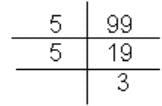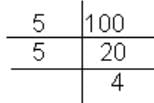Test Level 2: Number System - 2 - CAT MCQ
20 Questions MCQ Test - Test Level 2: Number System - 2
Find the last digit of the following sum.
1! + 2! + 3! + 4! + ... + 100!
There are two co-primes such that one number is exactly 8 times the other. What is the sum of the two numbers?
If u is an even number and v and w are odd numbers, then which of the following is not an odd number?
If x and y are two co-primes, then which of the following is true?
If a + b = c, where a, b and c are positive single-digit integers, what is the greatest possible value of the product abc?
Which of the following must be true for three positive consecutive integers?
I. Their product is always divisible by 6.
II. Their sum is always divisible by 3.
III. Their product is always divisible by 4.
Find the smallest value of x such that x! ends with exactly 23 zeros.
How many two-digit numbers have exactly five factors?
If N = 15 × 30 × 45 × 60 × … × 1500, what will be the number of zeros at the end of N?
A number when divided by a divisor left a remainder of 23. When twice the number was divided by the same divisor, the remainder was 11. Find the divisor.
The arithmetic mean of two numbers is smaller by 24 than the larger of the two numbers and the GM of the same numbers exceeds by 12 the smaller of the numbers. Find the numbers.
Given x and n are integers, (15n3 + 6n2 + 5n + x)/n is not an integer for what condition?
If a number is multiplied by 22 and the same number is added to it, then we get a number that is half the square of that number. Find the number
The sum of two numbers is 20 and their geometric mean is 20% lower than their arithmetic mean. Find the ratio of the numbers.
The highest power on 990 that will exactly divide 1090! is
If 146! is divisible by 6n, then find the maximum value of n.
The units digit of a two-digit number is greater than its tens digit by 2, and the product of that number by the sum of its digits is 144. Find the number.
















